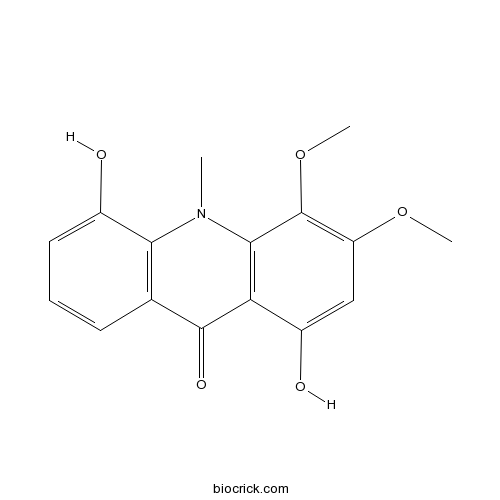Citrusinine ICAS# 86680-32-2 |

Quality Control & MSDS
3D structure
Package In Stock
Number of papers citing our products

| Cas No. | 86680-32-2 | SDF | Download SDF |
| PubChem ID | 5487772 | Appearance | Orange powder |
| Formula | C16H15NO5 | M.Wt | 301.29 |
| Type of Compound | Alkaloids | Storage | Desiccate at -20°C |
| Solubility | Soluble in Chloroform,Dichloromethane,Ethyl Acetate,DMSO,Acetone,etc. | ||
| Chemical Name | 1,5-dihydroxy-3,4-dimethoxy-10-methylacridin-9-one | ||
| SMILES | CN1C2=C(C=CC=C2O)C(=O)C3=C1C(=C(C=C3O)OC)OC | ||
| Standard InChIKey | UTEAJHNFBCLZHN-UHFFFAOYSA-N | ||
| Standard InChI | InChI=1S/C16H15NO5/c1-17-13-8(5-4-6-9(13)18)15(20)12-10(19)7-11(21-2)16(22-3)14(12)17/h4-7,18-19H,1-3H3 | ||
| General tips | For obtaining a higher solubility , please warm the tube at 37 ℃ and shake it in the ultrasonic bath for a while.Stock solution can be stored below -20℃ for several months. We recommend that you prepare and use the solution on the same day. However, if the test schedule requires, the stock solutions can be prepared in advance, and the stock solution must be sealed and stored below -20℃. In general, the stock solution can be kept for several months. Before use, we recommend that you leave the vial at room temperature for at least an hour before opening it. |
||
| About Packaging | 1. The packaging of the product may be reversed during transportation, cause the high purity compounds to adhere to the neck or cap of the vial.Take the vail out of its packaging and shake gently until the compounds fall to the bottom of the vial. 2. For liquid products, please centrifuge at 500xg to gather the liquid to the bottom of the vial. 3. Try to avoid loss or contamination during the experiment. |
||
| Shipping Condition | Packaging according to customer requirements(5mg, 10mg, 20mg and more). Ship via FedEx, DHL, UPS, EMS or other couriers with RT, or blue ice upon request. | ||

Citrusinine I Dilution Calculator

Citrusinine I Molarity Calculator
| 1 mg | 5 mg | 10 mg | 20 mg | 25 mg | |
| 1 mM | 3.3191 mL | 16.5953 mL | 33.1906 mL | 66.3812 mL | 82.9765 mL |
| 5 mM | 0.6638 mL | 3.3191 mL | 6.6381 mL | 13.2762 mL | 16.5953 mL |
| 10 mM | 0.3319 mL | 1.6595 mL | 3.3191 mL | 6.6381 mL | 8.2977 mL |
| 50 mM | 0.0664 mL | 0.3319 mL | 0.6638 mL | 1.3276 mL | 1.6595 mL |
| 100 mM | 0.0332 mL | 0.166 mL | 0.3319 mL | 0.6638 mL | 0.8298 mL |
| * Note: If you are in the process of experiment, it's necessary to make the dilution ratios of the samples. The dilution data above is only for reference. Normally, it's can get a better solubility within lower of Concentrations. | |||||

Calcutta University

University of Minnesota

University of Maryland School of Medicine

University of Illinois at Chicago

The Ohio State University

University of Zurich

Harvard University

Colorado State University

Auburn University

Yale University

Worcester Polytechnic Institute

Washington State University

Stanford University

University of Leipzig

Universidade da Beira Interior

The Institute of Cancer Research

Heidelberg University

University of Amsterdam

University of Auckland

TsingHua University

The University of Michigan

Miami University

DRURY University

Jilin University

Fudan University

Wuhan University

Sun Yat-sen University

Universite de Paris

Deemed University

Auckland University

The University of Tokyo

Korea University
- 6a,7-Dehydroboldine
Catalog No.:BCN9593
CAS No.:91599-23-4
- Boschnaloside
Catalog No.:BCN9592
CAS No.:72963-55-4
- Taccaoside E
Catalog No.:BCN9591
CAS No.:1858199-00-4
- 3'-Hydroxy-3,5,8,4',5'-pentamethoxy-6,7-methylenedioxyflavone
Catalog No.:BCN9590
CAS No.:82668-94-8
- 11β,13-Dihydrotaraxinic acid
Catalog No.:BCN9589
CAS No.:1274668-83-5
- Isostephodeline
Catalog No.:BCN9588
CAS No.:56648-85-2
- Blumenol B 9-O-glucoside
Catalog No.:BCN9587
CAS No.:114226-08-3
- Runanine
Catalog No.:BCN9586
CAS No.:100485-12-9
- (+)-Isoampelopsin F
Catalog No.:BCN9585
CAS No.:354553-38-1
- 3'-Hydroxy-3,5,6,7,8,4',5'-heptamethoxyflavone
Catalog No.:BCN9584
CAS No.:5244-28-0
- Goyaglycoside d
Catalog No.:BCN9583
CAS No.:333332-50-6
- Actinodaphnine
Catalog No.:BCN9582
CAS No.:517-69-1
- Junosine
Catalog No.:BCN9595
CAS No.:103956-34-9
- Tannagine
Catalog No.:BCN9596
CAS No.:123750-34-5
- Sinococuline
Catalog No.:BCN9597
CAS No.:109351-36-2
- (2R,3R)-Glucodistylin
Catalog No.:BCN9598
CAS No.:27297-45-6
- 3β-Hydroxy-7β,25-dimethoxycucurbita-5,23-dien-19-al
Catalog No.:BCN9599
CAS No.:85372-69-6
- Norushinsunine
Catalog No.:BCN9600
CAS No.:3175-84-6
- 16-Oxoserratenediol
Catalog No.:BCN9601
CAS No.:24513-52-8
- Aquilegiolide
Catalog No.:BCN9602
CAS No.:94481-79-5
- Menisdaurilide
Catalog No.:BCN9603
CAS No.:67765-59-7
- 7,7'-Dihydrotaiwanin C
Catalog No.:BCN9604
CAS No.:216955-79-2
- Stepharine
Catalog No.:BCN9605
CAS No.:2810-21-1
- Taiwanin C
Catalog No.:BCN9606
CAS No.:14944-34-4
A new flavonoid from the leaves of Atalantia monophylla (L.) DC.[Pubmed:29600742]
Nat Prod Res. 2019 Apr;33(8):1115-1121.
A new flavonoid, atalantraflavone (1) as well as eight known compounds including atalantoflavone (2), racemoflavone (3), 5,4'-dihydroxy-(3'',4''-dihydro-3'',4''-dihydroxy)-2'',2''-dimethylpyrano-(5'',6' ':7,8)-flavone (4), lupalbigenin (5), anabellamide (6), Citrusinine I (7), p-hydroxybenzaldehyde (8), and frideline (9), were isolated from the leaves of Atalantia monophylla (L.) DC. Focusing on Alzheimer's disease, acetylcholine esterase (AChE) inhibition and antioxidant activity were evaluated using the modified Ellman's method and the ABTS scavenging assay, respectively. It was found that isoflavonoid 5, lupalbigenin, showed 79% inhibition to AChE and was 1.4-fold stronger than the tacrine standard. In addition, acridone 7, Citrusinine I, displayed 90.68% antioxidant activity.


